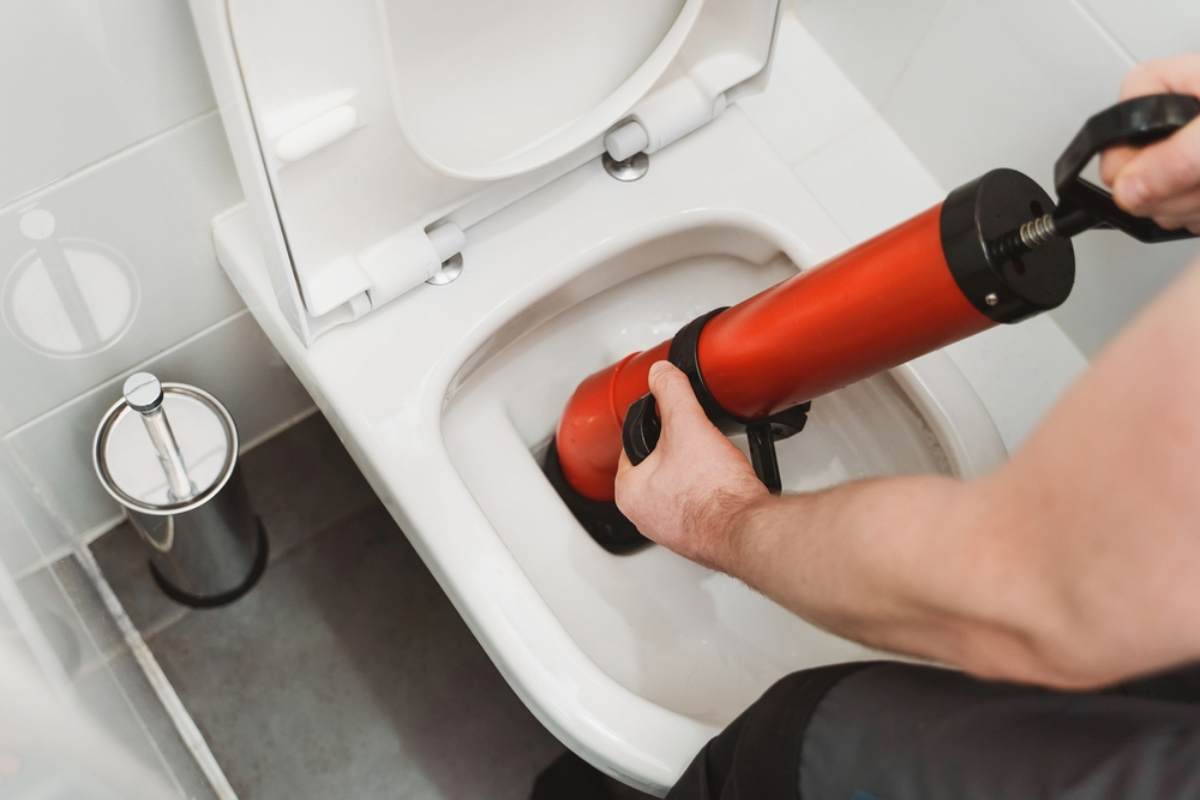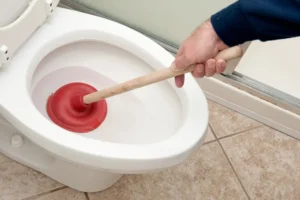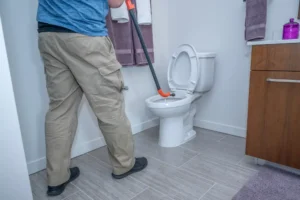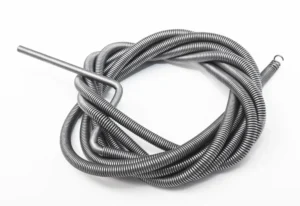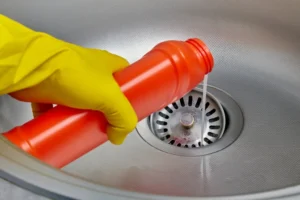A blocked toilet is an unpleasant household reality that can cause disturbances to daily living. Due to the frustration, it causes, the possibility of other plumbing issues, and the requirement to keep our houses clean and hygienic, it is essential to solve this immediately. The need for immediate attention and resolution for a clogged toilet is underscored by the fact that putting it off might result in more serious problems and higher repair expenses.
Identifying the Severity of the Blockage
Identifying the severity of a toilet blockage is essential in determining the appropriate course of action for clearing it effectively. Here are some key indicators to help you assess the seriousness of the clog:
- Slow Drainage: If the water is draining slowly after flushing, it may suggest a partial blockage. This is typically less severe and can often be resolved with basic methods.
- Water Level: If the water level in the bowl rises significantly after flushing and doesn’t subside, it indicates a more substantial blockage, possibly in the drainpipe. This requires more immediate attention.
- Gurgling Sounds: Unusual gurgling or bubbling noises coming from the toilet or nearby drains may signify a blockage further down the plumbing system, which can be a serious issue.
- Foul Odors: Persistent foul odors emanating from the toilet or drains may indicate a severe blockage, with potential waste backup.
Tools You’ll Need to Unblock a Toilet
To properly and effectively unblock your toilet, you may need a combination of tools that takes account of the following:
Plunger
A standard cup plunger or flange plunger is a must-have for most toilet blockages. It creates suction and pressure to dislodge clogs. Ensure a good seal around the drain, then push and pull vigorously to clear the obstruction.
Toilet Auger
Also known as a closet auger or plumbing snake, this tool is useful for stubborn blockages that a plunger can’t handle. Insert it into the drain and turn the handle to break up or retrieve the clog.
Plumber’s Snake
This is a more versatile and longer version of the toilet auger. It can reach deeper into the pipes and is handy for clearing blockages beyond the toilet trap.
Gloves
Disposable or rubber gloves are essential to protect your hands from germs and dirty water during the unclogging process. We would advise covering up your arms too.
Bucket
A bucket is handy for bailing out excess water from the toilet bowl before you begin the unclogging process, preventing spills.
Old Towels or Rags
These can be placed around the toilet to catch any spills or splashes, making cleanup easier.
Safety Goggles
While not always necessary, safety goggles can protect your eyes from potential splashes or debris.
Chemical Drain Cleaner
Use chemical drain cleaner cautiously and only if recommended for toilets. It can be effective for minor blockages caused by organic matter buildup.
Basic Plunger Technique: The First Line of Defense
Using a plunger effectively is often the first line of defense when clearing a toilet clog. Here’s a step-by-step guide:
Prepare Your Workspace
- Put on gloves to protect your hands.
- Lay down old towels or rags around the toilet to catch any spills or splashes.
- Ensure there’s enough water in the bowl to cover the plunger’s suction cup.
Position the Plunger
- Hold the plunger by the handle, ensuring a firm grip.
- Place the plunger’s suction cup over the drain hole at the bottom of the toilet bowl, ensuring a good seal.
Create a Seal
- Press down firmly on the plunger to create a seal. The suction cup should cover the drain opening completely.
Apply Pressure and Suction
- Push down on the plunger’s handle, then pull up forcefully without breaking the seal. This action creates pressure and suction, which can dislodge the clog.
Repeat the Plunging
- Continue plunging vigorously for about 15-20 seconds, or until you feel the clog break free. Maintain a good seal and avoid lifting the plunger off the drain.
Check for Drainage
- Gently flush the toilet to see if the water drains properly. If it does, the clog is likely cleared.
Repeat if Necessary
- If the clog persists, repeat the plunging process several times. It may take a few attempts to completely clear the obstruction.
Dispose of Waste Properly
- Dispose of any waste or debris that may have come up during the process in a trash bag or toilet.
Clean Up
- Remove the gloves and wash your hands thoroughly.
- Clean and disinfect the plunger before storing it.
Alternative Approach
If plunging doesn’t work to clear a toilet blockage, there are several alternative DIY methods to try before contacting a plumber:
Toilet Auger
- Use a toilet auger or closet auger as an extension of the plunger.
- Insert the auger into the drain and turn the handle clockwise to break up or retrieve the clog.
- Be cautious not to force the auger too vigorously, as it may damage the toilet.
Chemical Drain Cleaner
- Use a chemical drain cleaner specifically designed for toilets, following the manufacturer’s instructions carefully.
- Be cautious and use this method as a last resort, as some chemicals can be harsh and harmful to plumbing.
Chemical Drain Cleaners: Pros and Cons
Chemical drain cleaners can be effective in clearing minor clogs when used correctly, but they come with both pros and cons.
Pros
- Convenience: Chemical drain cleaners are readily available at most stores and are easy to use, making them a convenient option for DIY homeowners.
- Cost-Effective: They are generally more affordable than calling a professional plumber, making them an attractive choice for budget-conscious individuals.
- Speed: Chemical drain cleaners often work quickly, providing a relatively fast solution to minor clogs.
Cons
- Safety Concerns: Chemical drain cleaners contain corrosive chemicals, which can be hazardous if not handled properly.
- Environmental Impact: Many chemical drain cleaners contain harsh, environmentally damaging chemicals. Improper disposal can harm the environment.
- Limited Effectiveness: Chemical drain cleaners may not work on all types of clogs. They are often less effective against major obstructions, tree roots, or solid objects.
- Pipe Damage: Repeated use of chemical drain cleaners can potentially damage your plumbing pipes over time due to the corrosive nature of the chemicals.
When to Use Chemical Drain Cleaners:
Chemical drain cleaners are best used for minor clogs caused by hair, soap scum, or grease buildup in sink or shower drains. They should only be used when:
Other methods, such as plunging, haven’t been successful.
-
- You have carefully read and understood the product’s instructions.
- You can take appropriate safety precautions, including wearing protective gear and ensuring good ventilation.
- You are aware of the potential risks and limitations associated with chemical drain cleaners.
When to Call a Professional Plumber
-
- Persistent Blockage: If DIY methods, including plunging and using a toilet auger, fail to clear the blockage after multiple attempts, it’s time to call a professional plumber.
- Recurring Clogs: If your toilet experiences frequent clogs despite your best efforts to prevent them, it could indicate an underlying plumbing issue that requires professional assessment and repair.
- Multiple Fixture Backup: When multiple fixtures (toilets, sinks, showers) in your home are backing up simultaneously or draining slowly, it may signal a problem in the main sewer line, necessitating professional intervention.
- Foul Odors or Gurgling Noises: Unusual odors or gurgling sounds coming from the toilet or drains can indicate significant plumbing issues that need expert attention.
- No Improvement: If the situation doesn’t improve, or if you’re unsure about the cause of the blockage, it’s safer to consult a professional plumber to prevent further damage to your plumbing system.
Frequently Asked Questions about Toilet Blockages
Are there any safety precautions I should take when attempting to unblock a toilet?
Yes, wear gloves and eye protection to prevent contact with harmful bacteria and chemicals. Ensure proper ventilation when using chemical drain cleaners, and never mix different types of cleaners.
Is it necessary to clean up the area around the toilet after unblocking it?
Yes, it’s advisable to clean and disinfect the area to maintain hygiene. Dispose of any waste or debris properly and wash your hands thoroughly.
Can I use a plunger and chemical drain cleaner together to unblock a toilet?
It’s generally not recommended to combine these methods as they can create a hazardous chemical reaction. Choose one method and follow safety guidelines accordingly.
How can I prevent damage to my plumbing system while attempting to unblock a toilet?
Use gentle and controlled force when using a plunger or auger to avoid damaging the toilet or pipes. If unsure, consult a professional plumber to avoid causing more extensive harm.
Conclusion
In a nutshell, dealing with a blocked toilet might be uncomfortable, but with the proper information and skills, you can frequently fix the problem yourself. Try using a plunger first, and if that doesn’t work, try using a toilet auger or hot water and soap. When utilizing chemical drain cleaners, keep in mind that safety and environmental concerns should come first.
If you found this post useful, please forward it to friends or relatives who might be experiencing similar issues with toilet blockages. Consider saving this article as a favorite for later reference. Use the promo code to receive 10% off your first service with us if you ever require expert plumbing services.
